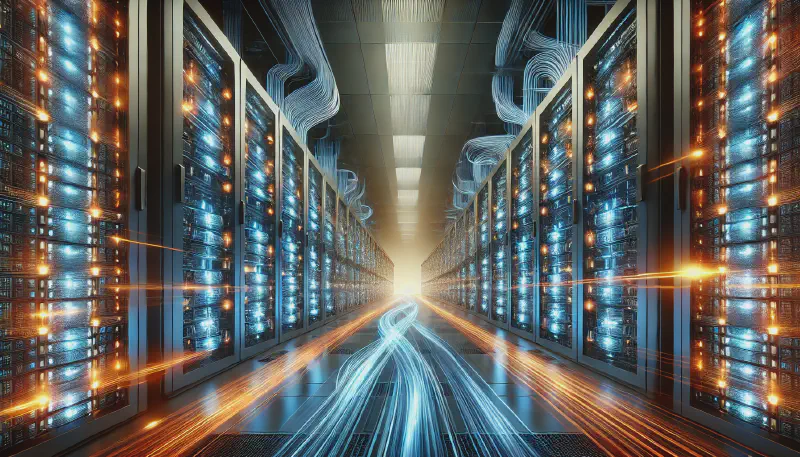Ever wonder how Google handles billions of searches every day? Or how Netflix streams movies to millions of people at once without crashing? The magic happens in massive data centers with clever network designs. Let’s peek inside these digital factories to see how they manage all that traffic!
Data Center Basics: The Digital Factory
- Think of a data center like a giant digital factory processing internet requests.
- Filled with racks of servers (the workers), connected by a web of cables and networking equipment.
- Biggest challenge: getting requests to the right “worker” efficiently without bottlenecks.
- Google’s data centers can handle over 100 petabytes of internet traffic daily (that’s 100,000 terabytes!)
The Front Door: Load Balancers
- Load balancers are like the reception desk at the digital factory.
- When millions of requests arrive, they decide which server should handle each one.
- Facebook uses a system called “Katran” that can route traffic at 65 million packets per second!
- Different strategies for different needs:
- Round-robin: “You take this one, now you take the next one…”
- Least connections: “Who’s least busy right now? You take it.”
- Geographic: “Send European users to European servers.”
- Task: prevent any single server from becoming overwhelmed.
The Building’s Layout: Network Topology
- Data centers use a “Clos Network” design (like a tree with multiple paths).
- Three main layers with specific jobs (imagine a corporate hierarchy):
The Workers: Access Layer (ToR - Top of Rack Switches)
- First point of contact for individual server racks.
- Amazon’s data centers might have hundreds of these in a single facility.
- Each connects 20-48 servers together in a rack.
- Task: connect individual servers to the network.
The Managers: Aggregation Layer
- Middle managers collecting traffic from multiple racks.
- Microsoft’s data centers connect each ToR to multiple aggregation switches for redundancy.
- Task: bundle traffic and route between different sections of the data center.
The Executives: Core Layer
- The superhighway of the data center.
- Google’s Jupiter network can deliver 1 Petabit per second of bandwidth here!
- Task: move massive amounts of traffic between aggregation switches and to the outside world.
Traffic Jams: Congestion Management
- Like having smart traffic lights that adapt to road conditions.
- Google uses a technique called “Explicitly Congestion Notification” (ECN).
- When traffic starts getting heavy, switches send signals to slow down transmission.
- Netflix automatically reroutes traffic during busy streaming hours (like after dinner time).
- Task: ensure smooth traffic flow even during peak times.
Multiple Factories: Global Load Distribution
- Big companies don’t rely on just one data center.
- Amazon has over 100 data centers grouped into 25+ regions worldwide.
- They use DNS-based global load balancing to direct users to the nearest data center.
- Example: When you watch a YouTube video, you’re probably connecting to a server less than 100 miles away.
- Task: distribute load across the globe and bring content closer to users.
When Disaster Strikes: Fault Tolerance
- Big data centers prepare for failures like a hospital prepares for emergencies.
- Facebook can shift entire workloads between data centers if one has problems.
- Google designs for “N+2 redundancy” - every critical component has two backups!
- Microsoft Azure has paired regions that back each other up in case of regional disasters.
- Task: keep services running even when components, connections, or entire facilities fail.
Energy Considerations: Powering the Factory
- Data centers consume massive electricity - Google uses about 12.7 terawatt-hours annually!
- Facebook’s Oregon data center uses outside air cooling instead of air conditioning when possible.
- Microsoft has underwater data centers (Project Natick) that use ocean water for cooling.
- Task: balance performance with power consumption and environmental impact.
Putting It All Together: The Full Request Journey
Imagine you search for “cute cat videos” on Google:
- Your request hits Google’s global load balancer, which sends you to the nearest data center
- Inside the data center, local load balancers direct your request to an available search server
- That server needs to look up information, so it talks to database servers through the three-layer network
- Multiple servers work on your request in parallel to make it fast
- All results are sent back through the same network layers to you
- All this happens in under half a second!
The Future: Where Data Centers Are Heading
- Edge computing: Mini data centers closer to users for even faster responses
- AI-driven traffic management: Networks that predict and prevent congestion before it happens
- Liquid cooling: Submerging servers in special non-conductive liquid to handle more powerful equipment
- Amazon, Google, and Microsoft are all experimenting with these technologies today
Whether you’re watching Netflix, scrolling through Instagram, or ordering from Amazon, you’re using these massive digital factories. Next time a webpage loads instantly or a video streams without buffering, remember the incredible network architecture making it all possible!
